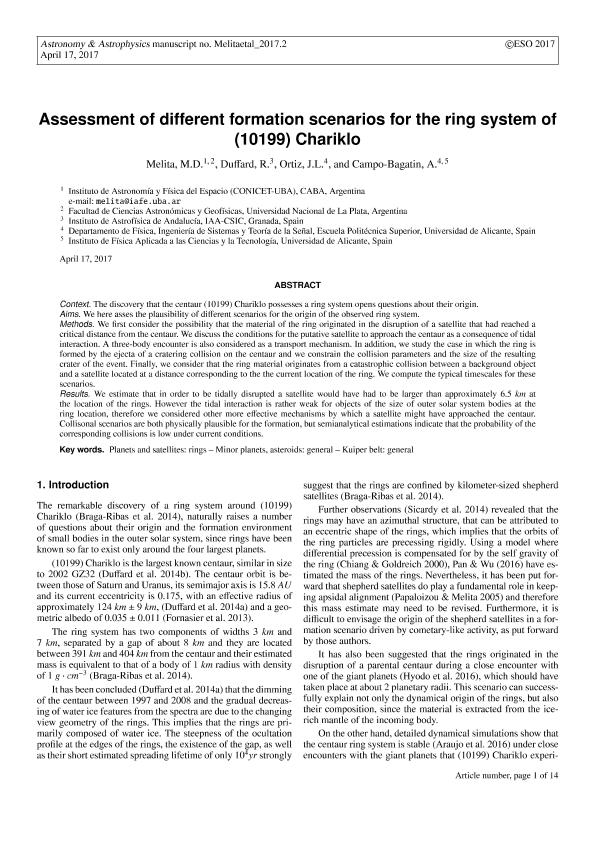Mostrar el registro sencillo del ítem
dc.contributor.author
Melita, Mario Daniel

dc.contributor.author
Duffard, R.
dc.contributor.author
Ortiz, J. L.
dc.contributor.author
Campo Bagatin, A.
dc.date.available
2017-07-11T20:21:27Z
dc.date.issued
2017-05
dc.identifier.citation
Melita, Mario Daniel; Duffard, R.; Ortiz, J. L.; Campo Bagatin, A.; Assessment of different formation scenarios for the ring system of (10199) Chariklo; EDP Sciences; Astronomy and Astrophysics; 602; A27; 5-2017; 1-8
dc.identifier.issn
0004-6361
dc.identifier.uri
http://hdl.handle.net/11336/20165
dc.description.abstract
The discovery that the centaur (10199) Chariklopossesses a ring system opens questions about their origin.We here asses the plausibility of different scenarios for the originof the observed ring system. We first consider the possibility that the material of the ringoriginated in the disruption of a satellite that had reached a criticaldistance from the centaur. We discuss the conditions for the putativesatellite to approach the centaur as a consequence of tidalinteraction. A three-body encounter is also considered as a transportmechanism. In addition, we study the case in which the ring is formedby the ejecta of a cratering collision on the centaur and weconstrain the collision parameters and the size of the resultingcrater of the event. Finally, weconsider that the ring material originates from a catastrophiccollision between a background object and a satellite located at adistance corresponding to the the current location of the ring.We compute the typical timescales for these scenarios. We estimate that in order to be tidally disrupted a satellitewould have had to be larger than approximately 6.5km at the locationof the rings. However the tidal interaction is rather weak for objectsof the size of outer solar system bodies at the ring location,therefore we considered other more effective mechanisms by which asatellite migt have approached the centaur. Collisonal scenarios are bothphysically plausible for the formation, but semianalyticalestimations indicate that the probability of thecorresponding collisions is low under current conditions.
dc.format
application/pdf
dc.language.iso
eng
dc.publisher
EDP Sciences

dc.rights
info:eu-repo/semantics/openAccess
dc.rights.uri
https://creativecommons.org/licenses/by-nc-sa/2.5/ar/
dc.subject
Asteroides
dc.subject
Centauros
dc.subject
Anillos Planetarios
dc.subject
Cometas
dc.subject.classification
Astronomía

dc.subject.classification
Ciencias Físicas

dc.subject.classification
CIENCIAS NATURALES Y EXACTAS

dc.title
Assessment of different formation scenarios for the ring system of (10199) Chariklo
dc.type
info:eu-repo/semantics/article
dc.type
info:ar-repo/semantics/artículo
dc.type
info:eu-repo/semantics/publishedVersion
dc.date.updated
2017-07-11T13:11:51Z
dc.journal.volume
602
dc.journal.number
A27
dc.journal.pagination
1-8
dc.journal.pais
Francia

dc.journal.ciudad
Paris
dc.description.fil
Fil: Melita, Mario Daniel. Consejo Nacional de Investigaciónes Científicas y Técnicas. Oficina de Coordinación Administrativa Ciudad Universitaria. Instituto de Astronomía y Física del Espacio. - Universidad de Buenos Aires. Facultad de Ciencias Exactas y Naturales. Instituto de Astronomía y Física del Espacio; Argentina
dc.description.fil
Fil: Duffard, R.. Consejo Superior de Investigaciones Cientificas; España
dc.description.fil
Fil: Ortiz, J. L.. Universidad de Alicante; España
dc.description.fil
Fil: Campo Bagatin, A.. Universidad de Alicante; España
dc.journal.title
Astronomy and Astrophysics

dc.relation.alternativeid
info:eu-repo/semantics/altIdentifier/url/https://arxiv.org/abs/1703.02295
dc.relation.alternativeid
info:eu-repo/semantics/altIdentifier/url/https://www.aanda.org/articles/aa/abs/2017/06/aa29858-16/aa29858-16.html
dc.relation.alternativeid
info:eu-repo/semantics/altIdentifier/doi/http://dx.doi.org/10.1051/0004-6361/201629858
Archivos asociados
